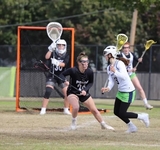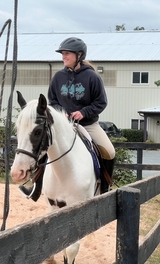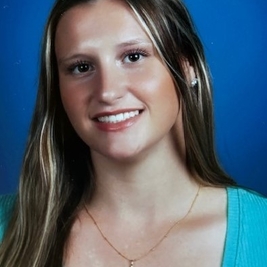Periacetabular Osteotomy: Hannah’s Story
Periacetabular Osteotomy: Hannah’s Story

Hannah has always been a kid on the move. At age 5, she was a figure skater, gymnast, lacrosse player and equestrian. By high school, she narrowed her focus to lacrosse and horseback riding. Her parents loved her passion and supported her efforts.
But in October 2023 – when Hannah was 16 – her active life careened to a stop. She fell off her horse twice in one day and the second time, she could barely stand up. She felt a sharp pain in her right hip. After a few days’ rest, she felt well enough to play in a lacrosse tournament. But, after one match, she had to stop.
“My hip felt like it was just going out (of the socket),” says Hannah, now 18. “I couldn’t run correctly, and my hip was killing me! The pain ran down my leg, though my knee and to my ankle.”
Surprising diagnosis
Her parents insisted she see a doctor and they visited a local orthopedic practice near their home in Northern Virginia. After X-rays and other imaging, the doctor revealed the likely cause of her pain – Hannah had a torn labrum in both of her hips. The labrum is a ring of cartilage that lines the edge of the hip socket, providing stability to the joint. Doctors also discovered Hannah had hip dysplasia in both hips, a disorder that can develop in early childhood when the hip socket is shallow or misshapen, which allows it to shift around inside the socket.
When hip dysplasia is diagnosed in early childhood it can be treated without surgery. In older patients, the condition is called acetabular dysplasia, and surgery is generally recommended if the pain doesn’t get better with rest and rehabilitation.
Hannah and her parents were shocked. “This was the first time we’d ever heard of hip dysplasia,” says Maureen, Hannah’s mom.
Doctors said the cartilage tear could be treated non-surgically with activity restrictions, anti-inflammatory medication, physical therapy and complimentary therapies like massage and cupping. The goal was to relieve the pain and rebuild her strength.
Small step forward, major step back

After a month of treatment in Virginia, Hannah tried lacrosse again, but it was too painful. She couldn’t walk without limping, much less run.
Hannah continued riding for her equestrian team for a few months, but by January, the pain had become unbearable. Hannah and her parents agreed: Something had to change.
Again, the family sought evaluation from doctors near their home. Two local physicians agreed Hannah needed surgery, but neither felt comfortable performing the complex operation she would need to reshape her hip socket to improve its function.
They recommended consulting a pediatric hip expert in Pennsylvania – Wudbhav “Woody” N. Sankar, MD, at Children’s Hospital of Philadelphia (CHOP).
Dr. Sankar’s name was familiar to Maureen. Since Hannah’s issues began, Maureen had talked with other parents from her daughter’s lacrosse team. Three people suggested she contact Dr. Sankar for a second opinion.
Searching online, Maureen learned Dr. Sankar was a national hip expert who served as director of the Young Adult Hip Preservation Program and leader of the Hip Disorders Program, both at CHOP, and was one of the most experienced surgeons to perform periacetabular osteotomy (PAO) surgery in teens and young adults – the procedure her other doctors had recommended.
Feeling encouraged, Maureen called CHOP. Maribeth Magarity, MSN, RN, an orthopedic nurse navigator, helped schedule Hannah’s appointment and secured all prior imaging scans.
Coming to CHOP
In March, Hannah and her mom met with Dr. Sankar at CHOP’s Philadelphia campus. He examined Hannah, reviewed her scans, and asked questions about her injury and pain levels during different activities. He described potential treatments including labrum repair and PAO surgery – the gold standard in surgical correction of acetabular dysplasia.
“When I met Dr. Sankar, I felt relieved, relaxed and understood,” Hannah says. “I wanted someone who’d done this surgery hundreds of times. I told him ‘I’m ready tomorrow.’”
“My daughter is very headstrong,” Maureen adds. “She wanted it fixed and to go back to her active life ASAP.”
Dr. Sankar urged the family to think carefully about surgery because it is a significant procedure with substantial recovery time. He encouraged Hannah to try an intra-articular (into the joint) cortisone shot – both as a short-term way to relieve pain, and as a diagnostic tool to determine if PAO surgery was the right approach.
Hannah decided to get the injection in her left hip, and the medication relieved some of her pain. Her family reported back to Dr. Sankar and surgery was scheduled. Hannah returned to CHOP for pre-operative testing.
Surgery and recovery

On May 23, Dr. Sankar performed the complex hip surgery, cutting Hannah’s right hip bone and repositioning it to more fully cover the ball of the femur, then securing it with four screws. The surgery took nearly three hours. Hannah stayed at the hospital for three days.
“I remember driving the 3 hours home from the hospital feeling like I had a newborn in the car,” Maureen says. “I had to be so careful. Thankfully, CHOP gave me lots of tips to make the ride more comfortable for Hannah – lots of pillows and blankets – and giving her pain meds right before the drive.”
Once home, Hannah couldn’t put any weight on her right leg for six weeks.
In early July, she saw Dr. Sankar for a follow-up visit at CHOP’s Specialty Care Center in King of Prussia, PA. He gave Hannah permission to begin physical therapy. She could begin weight-bearing activities and stand on her repaired leg, but still needed to use crutches to get around.
At three months post-op, she was walking well without crutches and felt great. She continues physical therapy to improve her gait, can now drive and has returned to school.
Looking ahead

Though still in recovery, Hannah is focused on the future. She started her senior year of high school and hopes to begin looking at colleges. She loves Florida and California. She’s positive about one thing: She wants to return to an active lifestyle.
But first, she has more hurdles. Her second PAO surgery – to correct the deformity in her left hip – is scheduled for December at CHOP with Dr. Sankar. She knows recovery will be challenging but hopes to be able to enjoy her senior-year rites of passage: Dancing at prom. Walking at graduation. Swimming and enjoying every minute of her last summer before college.
“I understand I have to go through this long process toward recovery and I’m hopeful I’ll get back to the same level of physical activity,” Hannah says. “I can’t thank CHOP and Dr. Sankar enough. Surgery went amazing, the scar looks good, and I can’t wait to start riding again!”
CHOP’s Hip Preservation Program focuses on hip conservation in young adults to stop continued damage and prevent the need for premature hip replacement.
